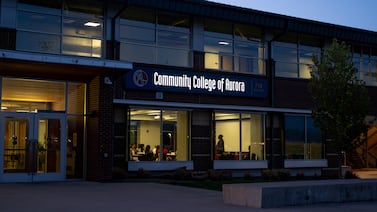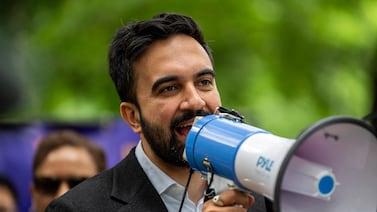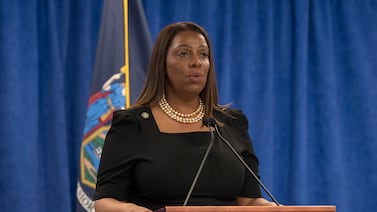Roughly 15% of the charter schools that received federal start-up funding either never opened or closed within a few years, according to a top U.S. Department of Education official, even though the schools received $174 million.
Assistant Education Secretary Roberto Rodríguez argued that those numbers underscore the need for greater oversight of the federal Charter Schools Program in an interview with Chalkbeat.
“It’s important to make sure that the stewardship of the program — particularly with respect to accountability and fiscal responsibility — is there,” he said.
It’s the Biden administration’s latest effort to fend off criticism of its proposed changes to regulations of the long-running program, which has awarded billions of dollars in grants since 1995 to help launch charter schools. Among other things, the proposed rules would require applicants to show that there is local demand for the schools and that they would not exacerbate segregation. The rules would also limit funds from going to charter schools run by for-profit companies or to schools that haven’t been approved to open.
The proposal has prompted a furious backlash from charter school supporters who say it would curtail charter growth and hurt applicants without institutional backing.
The closure of some schools — which Rodríguez suggests represents a lack of fiscal responsibility — is actually an example of the charter sector working as intended, countered Nina Rees, president of the National Alliance for Public Charter Schools.
“The underlying premise of this argument is that it is more acceptable to provide a substandard education and remain open, as is the case for too many low performing district schools,” she said.
More than 25,000 public comments for and against the regulations have poured in. The department must now respond to these comments and then can issue a final rule.
Rodríguez suggested that the administration isn’t backing away from making changes, but hinted that officials would try to make them less burdensome.
“The concern that’s been raised around the amount of time and effort that it would take to meet some of those requirements — that’s something we’re looking at and paying close attention to,” he said.
Highlights from the interview, edited for length and clarity, are below.
Chalkbeat: The proposal reads to me that, if a charter wants to open in a city with declining public school enrollment, that that school would have a harder time getting a federal CSP grant. And almost every city in the country right now is seeing declining enrollment. Do you agree with that characterization?
Roberto Rodríguez: No — district enrollment is only one of a number of factors that might indicate demand for new schools. We might look at access to specialized programs, we might look at waitlists at existing charter schools and demand for a school network to grow. The policy objective here was making sure that quality is the goal around our public charter schools.
When you say “quality” of schools, I don’t see anything in the proposal speaking to quality or student achievement. Can you say why that’s not included and what you meant when you talked about quality?
There are three aspects. One is providing greater accountability, transparency, and fiscal responsibility. The second is to make sure the program is driven by and more responsive to the needs of communities. The third is to encourage — not require, but encourage — collaboration between our federally funded charter school programs and other neighborhood schools in a way that is mutually beneficial and in a way that benefits students.
They don’t speak to student achievement per se in part because the federal government is not a charter authorizer. Those authorizing bodies should continue to be empowered to set the standards, including the academic standards, that schools need to meet. That is not an area that we believe was appropriate for the federal government to get involved in.
But we did want to get involved in some of those quality issues. This is in part trying to be responsive to the fact that we know 15% of grantees, as we looked back across the program, either never opened or were closed by the end of the grant period. That’s 930 schools that received over $174 million in federal funding. It’s important to make sure that the stewardship of the program — particularly with respect to accountability and fiscal responsibility — is there.
[According to details later shared with Chalkbeat, this analysis looked at 6,410 federal charter grants issued by states between 2001 and 2020. In 385 cases, the school did not open, while 545 schools quickly closed. Data was not available in 2013 or 2014, or from certain states.
A prior analysis by the Network for Public Education, which opposes charter schools, estimated larger figures using different methods. It found that 37% of schools that received a grant between 2006 and 2013 closed — at any point — or never opened, accounting for over $500 million in grant funding.
Rees of the National Alliance argued that the data released by the feds is outdated, and said that, according to her group’s analysis, about 6% of more-recent grants went to schools that have since closed.]
Let’s imagine that someone wanted to start a charter school and plans to serve mostly Black students because the founder believes those students have been historically under-served. But let’s also imagine the school would be in an area or a city that has many non-Black students. Would that charter school be seen by the department as exacerbating school segregation and thus less likely to receive a charter school grant?
I can speak to the policy objectives here, which are really to promote greater diversity — diversity by design — across all of our programs.
That said, I don’t think in your scenario that school would be disqualified from receiving a grant at the federal level. The intention here is not to mandate particular percentages of demographics in terms of enrollment at a charter school. It is to rather focus on encouraging more diverse-by-design schools and to make sure we’re taking a look at some of the factors around enrollment and projected enrollment in schools.
One of the criticisms from the charter school community is that these proposed rules, if enacted, would be burdensome. Do you worry at all that this would deter applicants, particularly those without any existing institutional support?
The goal here was to try to do more to solicit a needs analysis, just as we do with many other programs across the department that address K-12 education. There is a parallel objective around addressing for-profit entities that operate charter schools — not entities that might partner with charter schools for services, but entities that might be for-profit operators. Which is something the administration would like to address in this rule — to make sure we are not, from a federal level, supporting dollars that are going to for-profit entities operating charters.
All of that said, we’ve received a lot of comments on this rule that the team is reviewing right now, and we’re closely considering and deliberating on that feedback before making a decision to finalize anything.
One of the currents that we’ve seen in this comment is the worry about burden — the amount of time and effort that it would take to meet some of those requirements. That’s something we’re looking at and paying close attention to and will really be considering carefully before we finalize any rule.
The objective here is not to increase burden or create undue burden on applicants. The objective is to have some reflection of community input.
Can you speak about the timeline for issuing a rule and how that is going to intersect with running a CSP grant competition this year?
We are certainly continuing to wade through the many comments that came in. We are committed to addressing those comments and maintaining some of the objectives that I’ve spoken to and trying to weigh that with the existing timelines.
We know we need to try to finalize something, if it’s going to be applicable for this year’s funding, this summer. That is certainly a goal that we would like to meet. There are some other dollars that have a longer timeline within the program. We’re assessing that in real time now, honestly, to determine what’s possible this summer.






